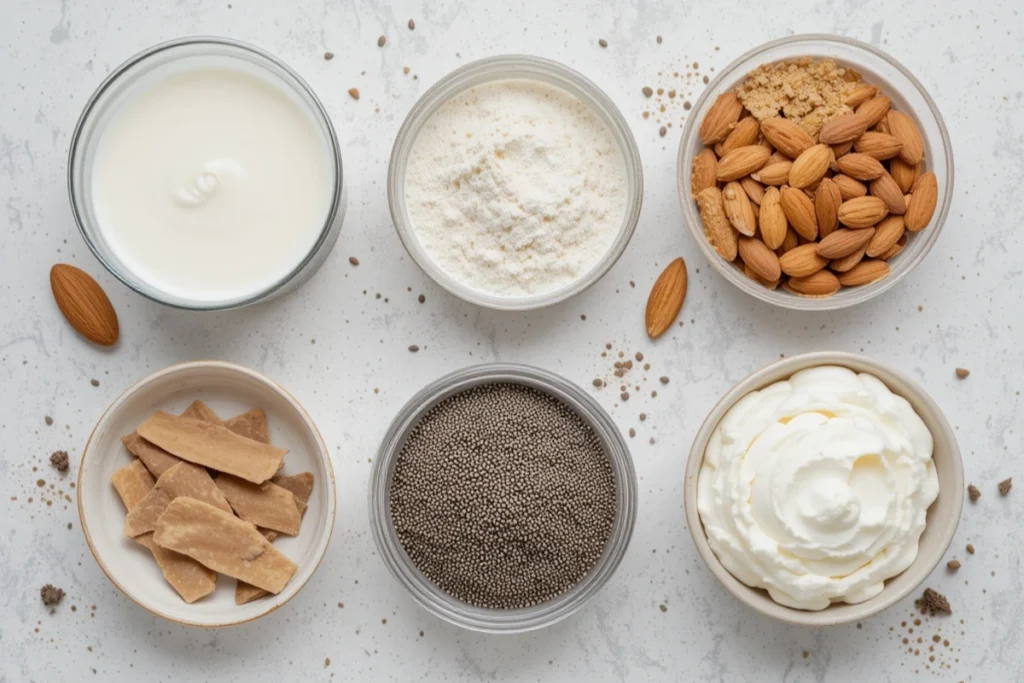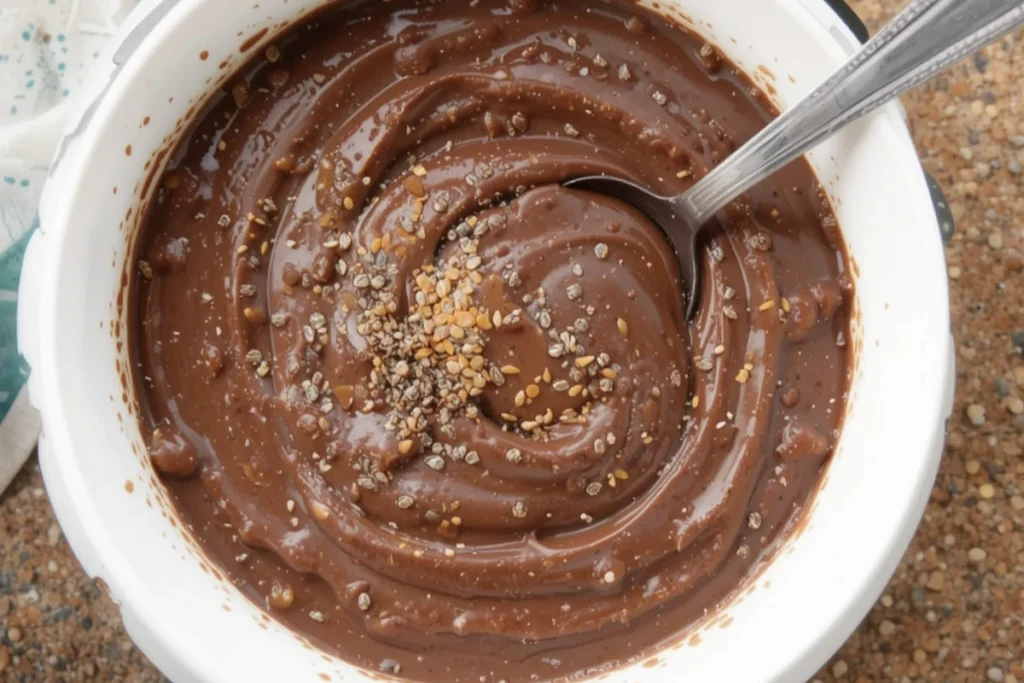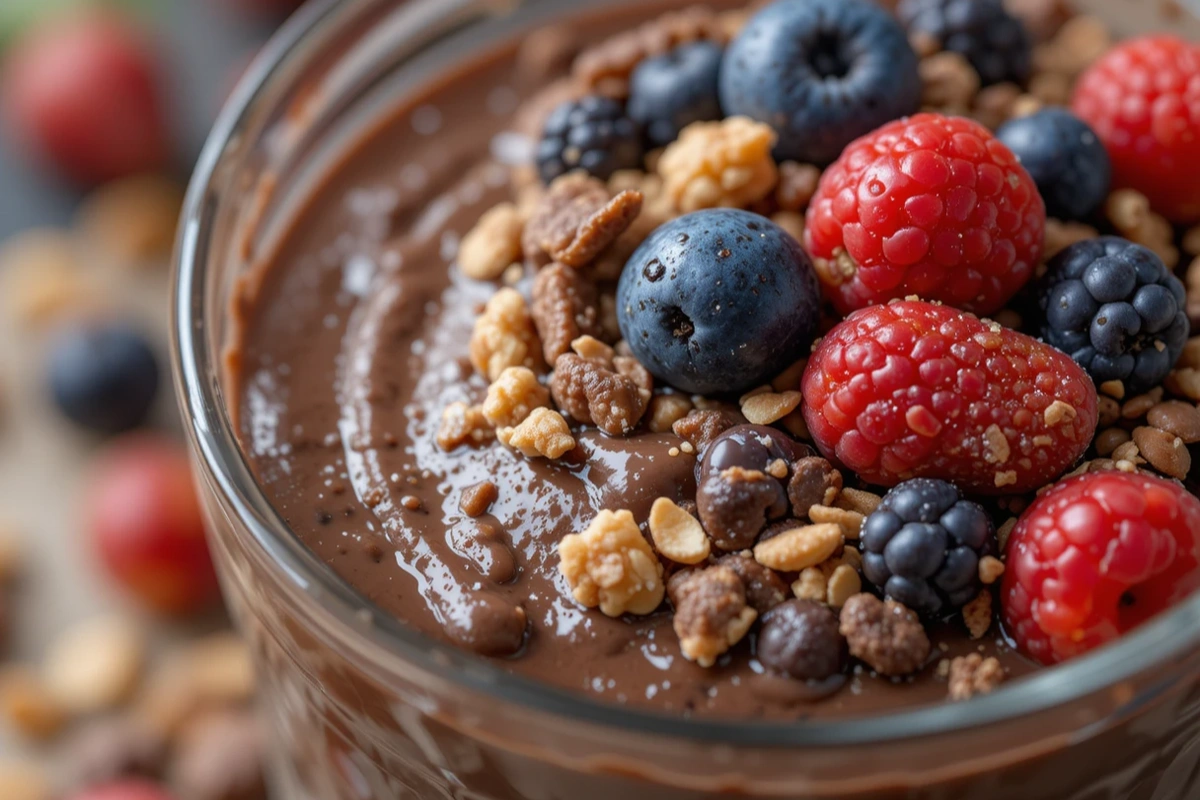Looking for a snack that’s delicious, nutritious, and doesn’t throw your health goals off track? Say hello to protein pudding—the high-protein treat that’s winning over fitness buffs, busy professionals, and dessert lovers alike. But with so many brands, recipes, and claims out there, how do you know if it’s truly good for you?
In this guide, we’re diving spoon-first into everything you need to know. We’ll break down the nutritional benefits, explore the different types of protein used, and show you how to pick (or make!) the healthiest versions. Whether you’re on a low-carb diet, managing your weight, or just want a smarter sweet fix, this is your go-to resource.
Let’s get started!
What Is Protein Pudding?
Understanding Protein Pudding
At its core, protein pudding is exactly what it sounds like—a creamy, dessert-like snack that’s been amped up with muscle-repairing protein. It’s a sweet treat that satisfies cravings without dumping a sugar bomb into your system. Unlike old-school pudding, which is often high in sugar and low in nutrients, this modern twist blends high-quality protein with balanced macros.
It usually comes in delicious flavors like chocolate, vanilla, peanut butter, or even matcha. Some versions use whey or casein protein, while others rely on plant-based options like soy or pea protein—perfect for vegans or those with dairy sensitivities.
Why Protein Pudding Is Trending in 2025
So, why is protein pudding suddenly everywhere?
Well, it ticks a lot of boxes. It’s convenient, portable, and, most importantly, it tastes good. It appeals to folks trying to bulk up, slim down, or just eat smarter. Plus, it’s ideal for those with busy lifestyles who want a no-fuss snack after workouts or during long workdays.
Nutritional Benefits of Protein Pudding
Protein Content and Muscle Recovery
Let’s face it—getting enough protein in your day can be tough, especially if you’re on the go. That’s where protein pudding truly shines. With 10–20 grams of high-quality protein per serving, this snack isn’t just tasty—it’s functional. Whether you’re lifting weights or just chasing toddlers around the house, protein is your body’s repair kit. It helps rebuild muscle, supports cell growth, and even fuels your metabolism.
Many protein puddings are packed with whey or casein, which are well-known for supporting muscle recovery. And for plant lovers, soy or pea protein versions do the job just as well. By sneaking a serving of protein pudding into your afternoon, you’re giving your body the nutrients it needs—without chewing through another chicken breast.
Balanced Macros and Steady Energy
One of the biggest wins? It’s not just about protein. A good protein pudding also includes a smart blend of carbs and healthy fats, giving you steady energy that doesn’t spike and crash like sugary treats do. Some varieties even toss in bonus micronutrients like calcium and vitamin D. Looking for something equally nourishing? YumyBite’s smoothie without yogurt is another protein-rich option worth trying!
So yes, this pudding isn’t just indulgent—it’s downright nutritious.
Types of Protein Used in Protein Pudding
Whey, Casein, and Plant-Based Proteins Explained
Ever checked the label on your protein pudding and wondered what all those protein types actually mean? Here’s the scoop: Whey protein is fast-digesting, making it perfect after workouts when your muscles are screaming for nutrients. On the flip side, casein protein digests slowly, helping you feel full for longer—which is awesome if you’re watching your weight.
Now, if dairy’s not your thing, don’t stress. Plant-based protein puddings made with pea, soy, or rice protein are just as powerful. They’re easy on the stomach and great for vegans or those with lactose intolerance. Bonus? Many are allergy-friendly and packed with natural nutrients.
How Protein Type Affects Digestion and Satiety
Different protein types do more than just change how fast you absorb nutrients—they also affect how long you stay full. Casein and soy proteins are slow-burners, keeping hunger at bay, while whey is more of a quick fix. This means if you’re snacking between meals or need a late-night treat, the right protein type makes all the difference.
Whatever your choice, choosing the right protein base in your pudding can seriously impact your health goals. And if you’re craving something similar but a little more airy, YumyBite’s cloud cake recipe is a light, protein-rich treat to explore next!
How Healthy Is Protein Pudding Really?
Are Protein Puddings Healthy or Just Hype?
The million-dollar question: Is protein pudding actually healthy—or just another marketing gimmick dressed in a pretty package?
Well, the truth is… it depends. While many protein puddings pack a punch of nutrients and support muscle recovery, not all are created equal. Some are clean and balanced, while others sneak in loads of sugar, additives, or artificial flavors. If your pudding has more chemicals than ingredients you can pronounce, that’s a red flag.
Look for options with natural protein sources, minimal added sugar (ideally under 5g per serving), and whole food ingredients. If it sounds like dessert but eats like a supplement—you’re golden.
What to Watch For: Additives, Sugar, and Artificial Sweeteners
Let’s get real—some brands try to make their protein pudding taste more like a milkshake. And that’s when things get sketchy. Hidden sugars, high-fructose corn syrup, or sneaky artificial sweeteners like sucralose or aspartame can spike your blood sugar or mess with digestion.
Instead, choose puddings sweetened with stevia, monk fruit, or even a bit of honey. These not only taste great but also keep your gut happier. A short, clean ingredient list? That’s the kind of label that says: “Eat me, I’m healthy!”
For more delicious recipes, check out YumyBite’s full recipe archive and discover something new to whip up!
Who Should Eat Protein Pudding?
Best for Athletes and Active Lifestyles
Whether you’re crushing a workout or just chasing your kids around, your body needs fuel. That’s why protein pudding is a go-to for athletes and busy bees alike. It helps muscles repair, rebuild, and recover without the heavy feeling of full meals.
Post-gym, a serving of pudding packed with whey protein can jumpstart muscle repair. If you’re more into endurance activities like running or cycling, the added carbs and fats in some puddings help refuel your energy stores—no blender required.
Weight Watchers, Busy Professionals, and Dessert Lovers
If you’re on a weight-loss journey, protein might become your secret weapon. It’s sweet, low-calorie, and filling—helping crush cravings before they lead you to a candy bar. Plus, slow-digesting proteins like casein keep you full longer, making late-night snack runs way less tempting.
Common Pitfalls and Misconceptions
Overconsumption: Can You Have Too Much Protein Pudding?
Here’s the deal—protein pudding might be a healthier snack, but that doesn’t mean you should eat it all day long. Like anything, moderation is key. Overeating even the healthiest snack can sneak in extra calories, sweeteners, and preservatives you weren’t counting on.
Some people treat protein snacks like a free pass, thinking, “It’s healthy, so I can have more.” But if your pudding has 180–200 calories a pop and you’re downing two or three a day, that adds up fast. Plus, too much protein—especially without enough water—can lead to digestive issues like bloating or discomfort.
Digestive Issues and Brand Variations
Not all protein puddings are gentle on your gut. Many brands use artificial additives, gums, or lactose-containing dairy that can be tough to digest. If you’re lactose-intolerant or sensitive to artificial sweeteners, go for plant-based options made with pea or soy protein.
Also, watch for misleading labels. Just because it says “high-protein” doesn’t mean it’s clean. Some puddings have more sugar than protein! Always read the ingredients and choose brands that keep it real and simple.
How to Choose the Best Protein Pudding
Reading the Nutrition Label Like a Pro
Shopping for the right protein pudding isn’t just about picking your favorite flavor. You’ve gotta flip that tub over and check the label. First things first—protein content. Aim for at least 10–15 grams per serving for that solid muscle-support kick.
Then, peek at the sugar. If it’s over 5 grams, especially with no fiber to slow it down, it’s probably more dessert than fuel. Stick with versions that use natural sweeteners like monk fruit or stevia instead of processed sugars or high-fructose syrup.
Don’t skip the calories either. If a pudding’s pushing 300+ calories, it better be doing more than just tasting good.
Top Ingredients to Look For (and Avoid)

So, what should your pudding actually contain? High on the list: whey, casein, or plant-based proteins, real cocoa or vanilla, and maybe a touch of healthy fat from nuts or seeds. What you don’t want? A laundry list of mystery chemicals.
Avoid sketchy ingredients like partially hydrogenated oils, artificial dyes, or vague terms like “natural flavors” with no context. The shorter and more natural the ingredient list, the better your body will feel after enjoying your protein pudding.
Easy Homemade Protein Pudding Recipes
Chocolate Protein Pudding (Vegan & Whey Versions)

Who says dessert can’t be smart and satisfying? Making protein pudding at home is surprisingly easy—and it gives you full control over ingredients.
Here’s a simple chocolate protein pudding recipe to try:
Whey version:
- 1 cup unsweetened almond milk
- 1 scoop chocolate whey protein
- 2 tbsp cocoa powder
- 1 tbsp chia seeds
- A few drops of stevia or honey to taste
Vegan version:
- Swap whey for a scoop of pea or soy protein
- Use plant-based milk like oat or coconut
Just mix everything in a bowl, chill for at least 2 hours, and enjoy! The chia seeds help thicken the pudding and add fiber, while the protein supports muscle repair.
Vanilla Protein Pudding with Greek Yogurt
If you’re more of a vanilla lover, this one’s for you.
- 1 cup plain Greek yogurt
- 1 scoop vanilla protein powder
- 1 tsp vanilla extract
- Sweetener of choice (like monk fruit)
- Fresh fruit or granola on top
This creamy mix makes a great breakfast or mid-day snack. And since it’s loaded with protein, it’ll keep you full for hours. Add crushed almonds or cinnamon to shake things up.
So why buy pre-made? Homemade protein pudding is cleaner, cheaper, and just as tasty.
Frequently Asked Questions About Protein Pudding
Can Protein Pudding Replace a Meal?
Technically, yes—but only sometimes. Protein pudding makes a solid mini-meal if paired with fruits, nuts, or whole grains. It lacks enough fiber and complex carbs to stand alone every time, though. Use it more as a snack or light meal, not a daily meal replacement.
Is Protein Pudding Safe for Kids?
Yes, in moderation! Kids can enjoy protein pudding, especially when made from wholesome ingredients like yogurt or plant-based milk. Just ensure the protein content isn’t too high and avoid artificial sweeteners or preservatives.
Best Time to Eat Protein Pudding?
Honestly? Anytime. Post-workout, it aids muscle recovery. As a mid-morning or afternoon snack, it curbs cravings. It’s even a smart dessert for those cutting back on sugar.
Can I Make Protein Pudding Without Protein Powder?
You sure can! Blend Greek yogurt, cottage cheese, or even silken tofu for a naturally protein-rich pudding. Toss in cocoa or vanilla for flavor. No powders needed—just whole, clean ingredients.
Print
Creamy Chocolate Protein Pudding
- Total Time: 10Min (plus chilling time)
- Yield: 2 servings 1x
Description
This rich and creamy chocolate protein pudding is the perfect blend of indulgence and nutrition. Packed with protein and naturally sweetened, it’s a guilt-free snack or post-workout treat that satisfies your sweet tooth while fueling your body.
Ingredients
-
1 cup unsweetened almond milk
-
1 scoop chocolate protein powder (whey or plant-based)
-
2 tablespoons unsweetened cocoa powder
-
1 tablespoon chia seeds
-
1 tablespoon nut butter (optional for creaminess)
-
1 teaspoon vanilla extract
-
1–2 teaspoons honey, maple syrup, or stevia (to taste)
-
Pinch of sea salt
-
Toppings (optional): sliced bananas, berries, shredded coconut, or granola
Instructions
-
In a medium mixing bowl, combine the almond milk, protein powder, cocoa powder, and chia seeds.
-
Whisk the ingredients together until smooth and fully combined.
-
Add the vanilla extract, sweetener of choice, nut butter (if using), and sea salt. Mix again.
-
Pour the mixture into a glass jar or serving bowl.
-
Cover and refrigerate for at least 2 hours, or overnight, until the pudding thickens.
-
Once set, give it a quick stir and top with your favorite healthy toppings.
-
Serve chilled and enjoy!
Notes
-
Flavor Variations: Use vanilla or caramel protein powder for a different twist.
-
Vegan Option: Use plant-based protein and maple syrup or stevia as sweetener.
-
Nut-Free Option: Skip nut butter or use sunflower seed butter instead.
-
Texture Tip: Blend the mixture before chilling for a smoother pudding.
-
Meal Prep Friendly: Make in advance and store in fridge for up to 3–4 days.
- Prep Time: 10Min
- Cook Time: 0Min
- Category: Snack, Dessert
- Method: No-Cook, Refrigerated
- Cuisine: American, Health-Inspired
Nutrition
- Serving Size: 1/2 of recipe
- Calories: 180
- Sugar: 4g
- Sodium: 180mg
- Fat: 8g
- Saturated Fat: 1.5g
- Unsaturated Fat: 6g
- Trans Fat: 0g
- Carbohydrates: 12g
- Fiber: 5g
- Protein: 17g
- Cholesterol: 15mg
Keywords: protein pudding, chocolate protein pudding, high protein snack, healthy dessert, post-workout snack, low sugar pudding, meal prep pudding

